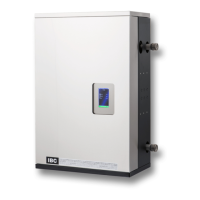INSTALLATION AND OPERATION INSTRUCTIONS
1-22
VFC 15-150 - VFC 45-225 MODULATING GAS BOILERS
PRESSURE VESSEL HEAD
Flow rate (gpm) 4 8 12 16 20
Head@ow(ftwc) 0.7 2.5 5.0 8.3 12.3
Table 6: Pressure Vessel Head
Ensure the pump is rated for the design circulating water temperatures; some
pumps have a minimum water temperature rating above the low temperature
potentialoftheboiler.Followinginstallation,conrmactualperformanceby
measuringΔ°T(underhighandlowowconditions)afterestablishingthecorrect
ringrate.
Werequirewaterowafterburnershutdowntoutilizelegacyheat–thisis
signicantduetothemassoftheheatexchanger(40Kg)plusits9Linternalwater
volume. Default software values will run the boiler’s primary pump for up to 5
minutes (300 seconds) after burner shutdown. Secondary pumps can be set to run
up to 5 minutes after burner shutdown (for the last calling load). As shipped, the
default software will run the Load 3 / DHW pump for 5 minutes to place the legacy
heat where it is useful – e.g. in the DHW tank. Any secondary pump can be set
to run for 0 – 300 seconds in the heat purge mode. Guard against deadheading
pumps when all zone valves are closed (see Section 2.7 Set Up & Load Denition).
The primary pump must be under the control of the boiler, to allow the boiler’s
owprovingroutinetorun.Theboilercontrollooksforow/noowduringa
pump on / off check on each start up. Ensure that temporarily wired primary or
secondarypumps(e.g.wiredexternallyduringthesystemll/purgephase)are
returned to the boiler’s control terminals. A “No Water Flow” error message will
otherwise be experienced on start-up.
There are two water pressure sensors, located on the boiler’s supply and return
water piping. These act to provide both low water pressure and low water level
cut-offprotectionandwaterowmeasurement.Schematicsforseveralpiping
layouts are provided, and additional drawings are available at www.ibcboiler.com.
Installersshallconformthepipingdesigntooneoftheprovidedcongurationsto
simplifythecontrolapplication,promotegoodloads-and-owsmanagement.
The VFC modulating series boilers offer unparalleled matching of heat generation
toradiation.Thelowminimumringisbettersuitedtolowthermalloads
presented in a typical multi-zoned radiation system. However, where individual
zones in a heating system have loads under 5,000 Btu/hr, the system will still
benetthroughuseofabuffertanktoensureacontrolledsupplytemperature,
and to prevent short cycling. Buffering should be added on the secondary piping
of the relevant load, to avoid bulking up the thermal mass of the primary piping
circuit (and potentially lengthen the duration of the transition from hot to cool
loads).
Propylene glycol solution is commonly used in a closed loop where freeze
protection is required. Its density is lower than that of water, resulting in
lowerthermalperformanceatagivenowandpressure.Asaruleofthumb,
a 50%:50% solution of propylene glycol and water will require an increased
system circulation rate (gpm up 10%), and system head (up 20%) to provide
performance equivalent to straight water.
VFCmodulatingseriesboilerscanbeconnecteddirectlytoaoorofnon-oxygen
barrier polybutylene material (PB tubing). For maintenance of warranty on such
systems,werequireevidenceofathoroughushingofallloops,plusinstallation
ofadirtseparatororsidestreamlter.Aseparator/ltermaintenanceroutine
NOTE
The Primary (boiler) pump
must be under the control
of the boiler and wired to
the correct yellow and white
wires labelled “Primary” in
the wiring box.
Failure to do so will result
in a no heat condition as the
boiler will interrupt start-up
with a “No Water Flow” error.
WARNING
Do not use automotive-type
ethylene or other types of
automotive glycol antifreeze,
or undiluted antifreeze of
any kind. This may result
in severe boiler damage. It
is the responsibility of the
Installer to ensure that glycol
solutions are formulated to
inhibit corrosion in hydronic
heating systems of mixed
materials. Improper mixtures
and chemical additives may
cause damage to ferrous and
non-ferrous components as
well as non-metallic, wetted
components, normally found
in hydronic systems. Ethylene
glycol is toxic, and may be
prohibited for use by codes
applicable to your installation
location. For environmental
and toxicity reasons, IBC
recommends only using non-
toxic propylene glycol.

